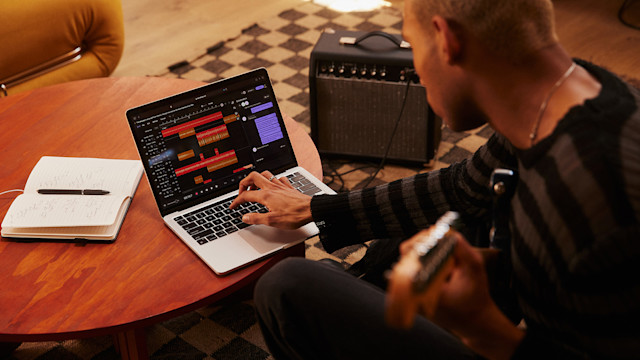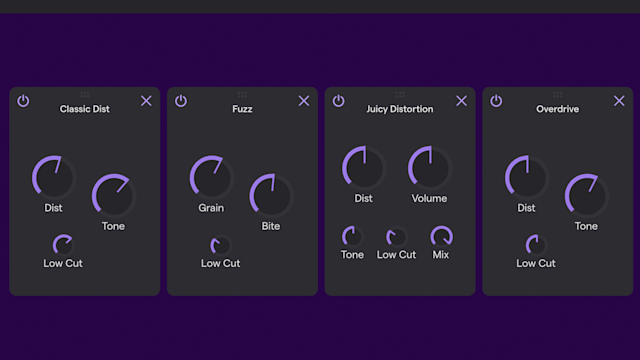What Is Distortion in Music and How To Use It When Mixing
November 14, 2023 | Anton Berner

Almost every music producer or creator will encounter a time when distortion will be essential to creating the deep, punchy sound they’re looking for. We’re all pretty familiar with distortion in one way or another, whether it’s wanted, like overdrive on a guitar, or unwanted, like when your speakers have a bad connection.
If you’ve ever wanted to know more about what distortion is and how you can use it correctly to enhance your music production, this is the guide for you.
First Off, What Is Audio Distortion In Music?
The original signal of audio is measured in a waveform. Distortion is a reference to significant alterations of this waveform, whether intentional or unintentional. Technically, any effects that change the audio signal (such as compression or EQ filters) qualify as distortion. However, in the music production space, distortion generally refers to more major changes to the waveform that alter the very nature of the sound.
Mixing with Distortion in Soundtrap
Why Would You Want To Use Distortion Effects In Music Production?
Now, if distortion heavily alters the original signal, why would you want it? As a creative effect, there are as many reasons as there are artists for desiring a distorted sound, but some of the common reasons are listed below:
Going Vintage: Add tonal character and warmth, making the music feel classic and appealing. It’s that Lo-Fi sound you hear in the chill and jazzhop genres. This is an example of the creative use of distortion in music.
Strength and Aggression: This can be used to make guitars or drums sound more intense and raw. Very popular in rock or metal genres.
New Creations: Novel sonic textures and sound spaces can be created by intentionally distorting elements. This can be a great way to add a unique touch to a composition.
Manipulate Dynamic Range: Specific distortion effects can be used to bring more detail to quieter passages and bring a fine level of control over the range of a piece.
Read more: 8 Important Mixing Tools Every Musician Needs
The Main Types of Sound Distortion Techniques
Next, let’s look at the main ways of using distortion in sound engineering to better understand how music producers use this effect to create the audio they are looking for.
Overdrive
Overdrive is a type of distortion effect that adds subtle harmonic distortion to a sound, primarily used on guitars. It is a mild form of distortion that adds warmth and character to the sound without being too aggressive.
This musical texture enhancement is achieved by pushing the input signal past its maximum level, creating a warm, saturated sound. Overdrive is available as an effect in Soundtrap.
Simply click on the piano keyboard button on your Soundtrap instrument track to open up the Instrument panel. To the right, click the “Add Effects” button and then “Overdrive” to add the effect. Feel free to see how tweaking this effect impacts the output!
Fuzz
Fuzz is an aggressive form of audio distortion that creates a gritty, buzzy sound. Producers use it to achieve a more distorted and intense sound, commonly found in rock, metal, and punk genres.
Fuzz is created by clipping the input signal, producing a square wave, and adding high-frequency harmonics. It's ideal for adding character and personality to a track.
Fuzz is also available as an effect in Soundtrap as a dynamic distortion application by using the “Add Effects” button in the Instrument panel.
Tape Saturation
Tape saturation is a form of audio distortion that simulates the warm and natural sound of analog tape recording. It adds harmonic distortion to the original audio signal, resulting in a fuller and richer sound with added depth and warmth.
Tape saturation is commonly used to add character and vintage feel to tracks, especially in genres like rock, blues, and funk. In Soundtrap, a similar effect can be created by using the “Classic Dist” effect in the “Add Effects” panel and tweaking the settings.
Clipping
When you amplify a waveform to the point where it goes beyond the range of frequencies your output device can process, you are adding the effect of clipping to your sound. It’s called clipping because you are effectively cutting off a certain number of frequencies.
This commonly occurs as a form of unintentional distortion when a track’s volume is raised too high. However, clipping is sometimes a desired effect. Technically, all of the distortion effects we have covered in this section intentionally cause some form of clipping.
Generally, most producers will rely on specialized effects instead of just cranking up the volume and destroying the sound quality. Soft clipping is another clipping technique that amplifies the waveform but rounds off soundwaves that peak past a certain limit, making a smoother sound.
Harmonic Distortion
Harmonic distortion in music is a type of audio distortion that occurs when additional frequencies are added to a sound.
These frequencies are multiples of the original sound's frequency and can add warmth, richness, and complexity to a track. It's commonly used in genres like rock, blues, and funk to create a vintage feel and add character to a track.
Harmonic distortion can also be used to enhance the sound of acoustic instruments like guitars and drums, even vocals, making them sound fuller and more dynamic.
As a music producer, you can experiment with harmonic distortion to add depth and texture to your music and make it stand out. In Soundtrap, use the “Tone” dial to play with this effect.
Inharmonic Distortion
Inharmonic distortion is a type of audio distortion that occurs when the harmonic frequency components of the sound are not in proportion to each other.
This creates a dissonant and harsh sound, making it an undesirable effect in most cases. However, in some cases, inharmonic distortion can be used creatively to add unique textures and tones to a track.
Music producers can manipulate inharmonic distortion to add complexity and character to their productions, especially in genres like experimental or electronic music. It can also be used to create sound effects or to add depth and movement to a sound.

Various Distortion Effects in Soundtrap
Best Practices For Mixing With Distortion
Here are a few of our top tips for using distortion in mixing and composition
Stay Subtle: Start small and work your way up. In most music, a little distortion goes a long way. Overdoing it can lead to an overly harsh or muddy mix.
Remember The Source: You can apply distortion to any instrument or even to vocals. However, distortion impacts different audio signals differently. Remember the unique characteristics of the sound you are distorting and ensure that you use the right effect.
Control The Low End: It’s important to strive for balanced mixing with distortion. Low-frequency content and bass-heavy elements can often be somewhat muddy by default. Excessive distortion can amplify these low-end frequencies and can potentially make this problem worse. Consider using high-pass filters or a dedicated EQ to control the low end before applying distortion.
Reference Regularly: Be sure to bounce back between the natural signal and the distorted sound to compare it with your reference tracks. It’s important to make sure your use of distortion is not excessive or out-of-line with your intended style.
Use Distortion as a Creative Tool: Think about why you are using distortion, instead of just throwing it in as an enhancing effect. It can actually be a key element in defining the character of your mix. Don’t be afraid to experiment and push boundaries for a distinctive sonic identity.
When Not To Use Distortion
While distortion can be a powerful tool in music production, there are certain situations where it might not be the best choice. Here are some instances where you might want to avoid using distortion:
Clarity
If you're looking for a clean and clear sound, distortion may not be the right choice. Distortion can add a lot of character and warmth to a sound, but it can also muddy up the mix and make it harder to distinguish individual elements. If you want a more transparent and precise sound, you might want to experiment with other effects like EQ, compression, or reverb.
Genre
While distortion is a popular effect in many genres like rock, metal, and punk, it may not be suitable for every type of music. If you're working on a piece that requires a more delicate or nuanced sound, distortion might overpower the subtleties of the performance. You'll want to consider the genre of the music and the emotional impact you're trying to achieve before deciding whether to use distortion.
Personal Preference
Ultimately, the decision to use distortion in a music production comes down to personal preference. If you don't like the sound of distortion or it doesn't fit with your creative vision, don't feel like you have to use it. There are countless other effects and techniques you can use to shape the sound of your music, and you should always prioritize your artistic instincts over any specific tool or effect.
Create Amazing Music Together In Soundtrap
Soundtrap is our online, browser-based digital audio workstation (DAW). It’s a fully-featured music creation sandbox that makes it easier than ever before to create amazing sounds and collaborate with your team.
If you want to get started trying out distortion for yourself in Soundtrap, check out this article here! It’s even got a sample project so that you can quickly see how different distortion effects work and sound.
About the author
Anton Berner is a music producer, audio engineer, and songwriter from Stockholm, Sweden. He's produced hip-hop & rap music since the early 2000s and his expertise is in vocal mixing and sample-based beat production. Anton is also the SEO & Content Manager @ Soundtrap and manages the blog and newsroom.
Get started with Soundtrap today!